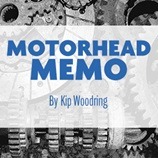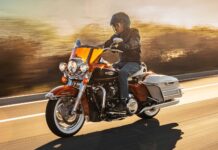Last month we delved into the world of Harley-Davidson frames, from the K-Model/Sportster era through the F-engine frames that housed the Shovelhead motors from 1966 until 1986—a hell of a run.

Same could be said for the first computer-designed five-speed frame that showed up in 1980 on FL touring models and in a revised and revered form on FX models in 1982. (OK… it’s two frames, but you get the idea!) In fact, the idea of individual frame designs for two different F-engine applications intended for two different roles was a first. From the day the FXR came on the scene, the handling, for a big bike of its type, was exemplary, legendary even. The FLT version worked remarkably well, particularly the light linear steering… right up until the advent of big-inch power. These frames introduced the concept of maintenance too, in the sense that the rubber mounts (and lateral links) didn’t live forever, so routine inspection and occasional replacement are required to keep things sharp and safe.

The FXR frame was gone by 1994 (excepting the few built in 1999–2000) and the FLT by 2008. In 2009, a new frame was introduced that put the FLT right back up there in terms of handling and stability, primarily via the re-think of those rubber mounts… using a “four-square” approach with one at each corner of the powertrain. The game changed again with the advent of the balancer-equipped Milwaukee-Eight engine. No more dancing on rubber at idle and a frame revision to solidly bolt in the new power plant. Stiffer and stronger yet!

Once upon a time the “long-primary” FX Big Twins had four frames: the aforementioned mentioned Shovel/Evo four-speed unit (until ’86), the first Softail, the next Softail, and the Dyna. Once four-speeds went away, we were quickly down to two.

The Softail, uniquely a “bought-in” frame, patented by Bill Davis (Google it), that owed more to style than function, set sales records (and generated long wait lists) immediately upon its introduction in late ’83 as a 1984 model… fitted with a four-speed for two model years. From 1986 Softails were five-speeds in (no surprise) yet another version of that frame. Several minor tweaks along the way, and the notable update, involving shock mounting in 1992, and that was it… until the year 2000 when it got completely redone for the Twin Cam engine (which also got “done” with counter-balancers). Now able to use that smooth motor for structural strength, the TC Softail frame mostly shed its welded-in seat post for a bolt-in stamped strut sorta thing… and lost a few pounds in the process. That frame lasted until, well, you know, Softail 3.0 in 2018! That frame sums up everything H-D has learned about making a stylish chassis actually perform! The shock location has moved up where almost all other similar frames park theirs and compliance has improved immeasurably, allowing a much stiffer frame to do its job. That leaves the Dyna.

Introduced with an Evo engine in 1991 the FXD frame was always flawed. Two reasons: first the positioning of the lower shock mounts about 6 inches in front of the rear axle… so it would look like old swingarm frames from the Shovelhead era. (Hey, it worked with Softails trying to look rigid… right?) Then, there was the decision to rubber mount the engine “fore and aft” with only two automotive-looking block-type mounts. Both decisions were (and are) liveable, but Dyna models had trouble with the mounts shearing that first year, and even when the rubber compound was changed to solve it, you were stuck with a harsh, handicapped rear suspension. Refinements ensued… notably the great stiffening of 2006! Maybe not perfect, but good enough that by the time the Dyna died in 2017, legions of fans bemoaned the fact. Can’t have been too bad then… huh? No FXR and no Softail 3.0… but determined riders could boogie pretty hard on an FXD anyway.

VRSC
I’m bound to get an argument from aficionados… but the V-Rod was the right engine in the wrong frame (or vice-versa)… compared to what “could have been.” The engine is a pip, adapted from the race-only VR1000 as it was. But heavy as, well, “not a true sportbike” heavy, but the decision to make it a muscle bike as a result… somehow led to steering geometry and cornering clearance that definitely focused on a “point-and-shoot” finished product. Wide tire versions that came later made that focus even clearer. The basic frame was rigid enough for duty in that arena and clever in the use of removable lower rails for engine service… but a 67” wheelbase? Really? Longer than a Softail! Seriously! Am I alone in thinking a more sport touring-oriented chassis would have given the VRSC a wider appeal than it ultimately ever had? A one-trick pony gets a bit boring after all.

Street 500/750
Look at the photo hereabouts. Nothing special in the Street frame at first glance… huh? Arguably, the best part is it works as planned for all-around riding—and—was designed from scratch to provide places to put things… things like ECM, BCM, modules and relays galore… to name the obvious. A lift of the seat and a look around will show those areas are pretty much stuffed with stuff that’s well hidden. (More than you can say for Sportsters.) Where it might stand improvement is sex appeal, detail finish and places to put things… things like passengers, luggage and add-on accessories. No mistake, H-D provided what they wanted to offer… but not much and not aftermarket. In spite of an update (the Street Rod) to make the “platform” seem more “sporty,” the existing frame and associated geometry ensures that you needn’t hit a race track to find the bike’s limits. I have to believe the platform could stand the addition of another frame and a model (or two) which you would want to take to track days… because it worked so well on the road. Excuse me… the “Street!”





















